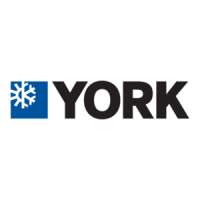43
Antifreeze Corrections
Aurora Control System
NOTE: Refer to the Aurora Base Control Application and
Troubleshooting Guide and the Instruction Guide: Aurora Interface and
Diagnostics (AID) Tool for additional information.
To check the unit control board for proper operation:
1. Disconnect thermostat wires at the control board.
2. Jumper the desired test input (Y1, Y2, W, O or G) to the
R terminal to simulate a thermostat signal.
3. If control functions properly:
• Check for thermostat and field control wiring (use
the diagnostic inputs mode).
4. If control responds improperly:
• Ensure that component being controlled is functioning
(compressor, blower, reversing
valve, etc.).
• Ensure that wiring from control to the component is
correct.
Troubleshooting
• Refer to the Aurora Base Control Application and
Troubleshooting Guide and the Instruction Guide: Aurora
Interface and Diagnostics (AID) Tool for additional
information.
Refrigerant Systems
To maintain sealed circuit integrity, do not install service gauges
unless unit operation appears abnormal. Compare the change in
temperature on the air side as well as the water side to the Unit
Operating Parameters tables. If the unit’s performance is not
within the ranges listed, and the airflow and water flow are known
to be correct, gauges should then be installed and superheat and
subcooling numbers calculated. If superheat and subcooling are
outside recommended ranges, an adjustment to the refrigerant
charge may be necessary.
NOTE:
Refrigerant tests must be made with hot water generator
turned “OFF”.
Verify that air and water flow rates are at proper levels
before servicing the refrigerant circuit.
Catalog performance can be corrected for antifreeze use. Please use the following table and note the example given.
Antifreeze Correction Example
ntifreeze solution is Propylene Glycol 20% by weight. Determine the corrected heating and cooling performance at 30°F and 90°F
respectively as well as pressure drop at 30°F for a 036.
The corrected cooling capacity at 90°F would be: 34,800 Btu/h x 0.969 = 33,721 Btu/h
The corrected heating capacity at 30°F would be: 29,300 Btu/h x 0.913 = 26,750 Btu/h
The corrected pressure drop at 30°F and 9 gpm would be: 13.4 feet of head x 1.270 = 17.02 feet of head
Antifreeze Type Antifreeze % by wt Heating Cooling Pressure Drop
EWT - °F [°C] 30 [-1.1] 90 [32.2] 30 [-1.1]
Water 0 1.000 1.000 1.000
Ethylene Glycol
10 0.973 0.991 1.075
20 0.943 0.979 1.163
30 0.917 0.965 1.225
40 0.890 0.955 1.324
50 0.865 0.943 1.419
Propylene Glycol
10 0.958 0.981 1.130
20 0.913 0.969 1.270
30 0.854 0.950 1.433
40 0.813 0.937 1.614
50 0.770 0.922 1.816
Ethanol
10 0.927 0.991 1.242
20 0.887 0.972 1.343
30 0.856 0.947 1.383
40 0.815 0.930 1.523
50 0.779 0.911 1.639
Methanol
10 0.957 0.986 1.127
20 0.924 0.970 1.197
30 0.895 0.951 1.235
40 0.863 0.936 1.323
50 0.833 0.920 1.399
WARNING: Gray area represents antifreeze concentrations greater than 35% by weight and should be
avoided due to the extreme performance penalty they represent.
LX SERIES INSTALLATION MANUAL

